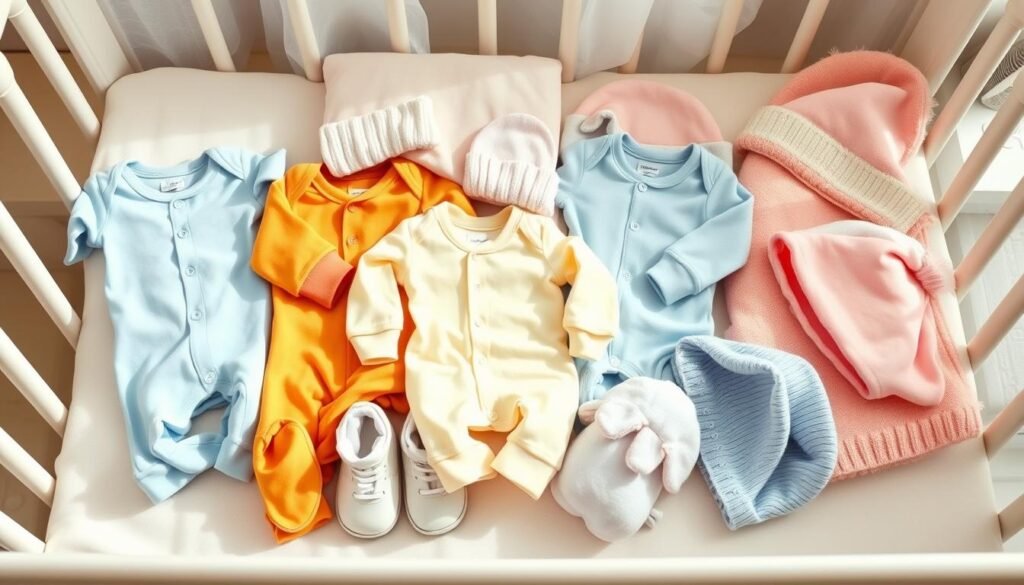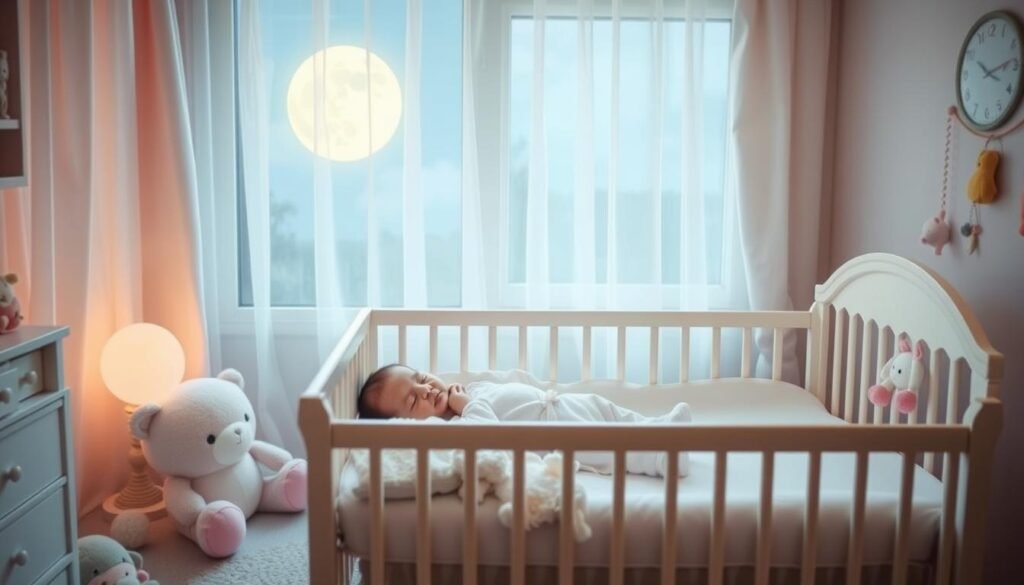As a new parent, figuring out how many baby clothes you need can be tough. It’s easy to want to buy everything, but it’s key to find a balance. Babies grow fast, so planning is essential. This guide will help you pick out the must-haves from newborn to 12 months, thinking about growth, laundry, and seasons.
Experts say you should have1 6-8 bodysuits, 4-6 sleepers, and 6-8 sets of tops and bottoms. Also, 2-3 swaddle blankets, 1-2 outerwear pieces, 2-3 hats and mittens, and 4-6 pairs of socks and booties1. For special occasions, 1-2 outfits and 2-3 extra items like bibs and blankets are good to have1. Since babies grow a lot in the first few months, having sizes from newborn to 3-6 months is smart1. Doing baby laundry every 2-3 days helps keep their clothes clean and plentiful1.
Knowing the2 right amount of clothes and planning ahead ensures your newborn has a great wardrobe for the first year2.
Understanding Baby Clothing Essentials: A Parent’s Guide
Starting to plan your baby’s wardrobe can be both fun and overwhelming. It’s important to find the right mix of clothes for practicality and budget. While it’s tempting to buy lots of cute outfits, focus on quality over quantity3. Good clothes that last will keep your baby comfy and stylish for their first year.
The Importance of Planning Your Baby’s Wardrobe
Planning your baby’s wardrobe carefully can really help your daily life. Choosing versatile, comfy pieces means you have enough without too much3. This way, you focus on clothes that grow with your baby, not ones that quickly outgrow.
Why Quality Matters More Than Quantity
When dressing your baby, quality should be your main concern3. Spending on durable, high-quality clothes saves money and keeps your baby comfortable. These clothes will last through lots of washing and wear, keeping your baby cozy and stylish.
Factors Affecting Your Baby Clothes Needs
Several things can change how many clothes your baby needs, like their growth rate and where you live3. Knowing these can help you create a minimalist wardrobe that fits your needs without breaking the bank.
| Age Range | Recommended Outfits per Day |
|---|---|
| 0-3 Months | 2 outfits + 1 sleeper |
| 3-6 Months | 1-2 outfits |
| 6-9 Months | 1 outfit |
| 9-12 Months | 1 outfit + 1 pajama set |
By considering these factors and choosing quality over quantity, you can create a baby capsule wardrobe that meets your needs. This approach ensures your baby has the essentials for a great first year.
How Many Clothes for Babies Are Needed for a Year
Finding the right amount of baby clothes for the first year can be tricky. Aim for about 14 outfits for each size range, for two changes a day4. This includes basics like 6-8 onesies, 4-6 sleepers, and 6-8 tops and bottoms4.
Don’t forget 2-3 swaddle blankets, 1-2 outerwear pieces, and 2-3 sets of hats and mittens4. Also, have 4-6 pairs of socks or booties and 1-2 special outfits for special occasions4.
It’s better to have fewer items and wash clothes more often than to buy too much4. Adjust the number of clothes based on your laundry schedule and your baby’s growth4. Consider hand-me-downs or gifts to cut down on buying more4.
Start with newborn sizes and have outfits ready for 0-3 and 3-6 months5. For newborns, have 14 different clothing options and 14 bibs for 3-6 months5. For 6-9 and 9-12 months, aim for 7 outfits for day and night each week5.
By planning ahead and keeping a balanced wardrobe, your baby will be comfortable and stylish without spending too much.
4.
Source: [link 1]5Source: [link 2]
Essential Clothing Items for Newborns (0-3 Months)
Getting your newborn (0-3 months) dressed can be both fun and challenging. You’ll want clothes that are comfy, easy to change, and grow with your baby. Let’s look at the key items for your baby’s wardrobe in these early months.
Must-Have Pieces for Your Newborn
For the first few months, choose soft, simple, and practical clothes. Newborn clothes fit babies weighing 5-8 pounds, and most fit newborn sizes for the first 4 weeks6. Essential items include:
- 10-15 newborn onesies or bodysuits678
- 7-10 pairs of soft pants or leggings678
- 7-10 sleepers or footed pajamas678
Recommended Quantities for Each Item
While the exact number needed may vary, here are some guidelines:
- 6-8 bodysuits for daily wear67
- 3-4 pairs of pants or leggings67
- 4-5 pajamas, sleepers, and/or footies6
- 1-3 special occasion outfits6
- 5-6 pairs of socks67
- 2-3 hats67
Special Considerations for Seasonal Babies
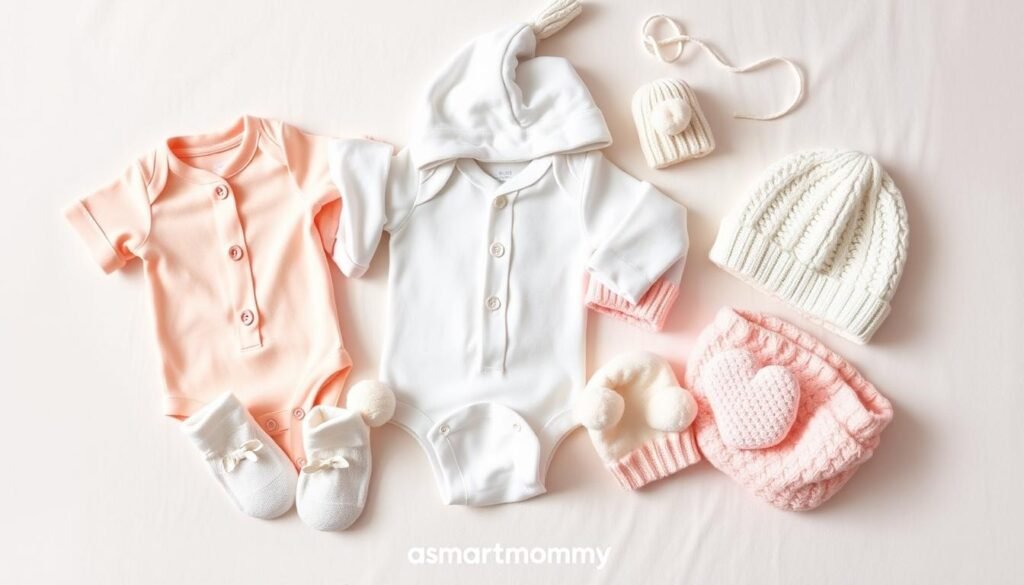
If your newborn is born in the cold months, add 2-3 hats and mittens to their wardrobe6. Skip shoes and choose socks or booties instead. Keep outfits simple and comfy, focusing on easy changes.
As your newborn grows fast, don’t spend too much on this size. Choose quality over quantity and aim for a versatile wardrobe that meets your baby’s changing needs6. With these newborn clothing essentials and baby clothing basics in mind, you’ll dress your little one in comfort and style.
Building a Wardrobe for Growing Babies (3-6 Months)
When your baby reaches 3-6 months, it’s time to update their clothes. You’ll need more onesies, soft pants, and sleepers. But, add some variety in styles and colors9.
Make sure to include 2-3 outfits for going out or photos. Babies this age are more active. So, pick clothes that let them move easily and are simple to change.
For a 3-6 month-old baby in fall and winter, you’ll need: 10-12 tops/onesies, 3-5 sweaters, 5-6 bottoms, 2-3 rompers, 3-5 pajamas, 2-3 hats, and 10 socks10. Prices vary, like stripe onesies for $28, wrap knit jackets for $30, and rib knit leggings for $1810.
When shopping, focus on clothes that are versatile and practical9. Choose items that can be layered and let your baby move freely. This way, they’ll be comfy and ready for anything. Don’t overdo it – add clothes as your baby grows9.
By dressing your baby for the 3-6 month range, you’ll keep them comfortable and stylish. With careful planning and a focus on quality, you’ll create a wardrobe that’s both versatile and practical10.
Clothing Needs During the Active Phase (6-9 Months)
When your baby reaches 6-9 months, their clothes need a change. They’re now moving around and need clothes that can keep up. Look for durable, comfy clothes that can handle crawling and exploring.
Choose stretchy fabrics and pants with reinforced knees. This gives your baby flexibility and protection11.
Choosing Clothes for Crawling Babies
Start with a basic wardrobe of 10-15 onesies, 7-10 pairs of pants, and 7-10 sleepers11. Don’t forget 3-4 pairs of socks and soft-soled shoes for standing practice. Clothes that are easy to put on and take off are best, as babies get more stubborn11.
Durability and Comfort Requirements
Choose clothes that can handle a baby’s active lifestyle. Opt for soft, stretchy, and breathable fabrics like cotton, bamboo, or jersey. Reinforced knees and elbows help prevent wear, and adjustable waistbands and snap closures make dressing easier12.
With your baby’s growing appetite, have 3-5 bibs ready for meals. Also, consider a splash mat, baby food maker, and food storage containers for solid foods12.
By picking practical, comfy, and adaptable clothes, your baby will stay happy and healthy during this active phase.
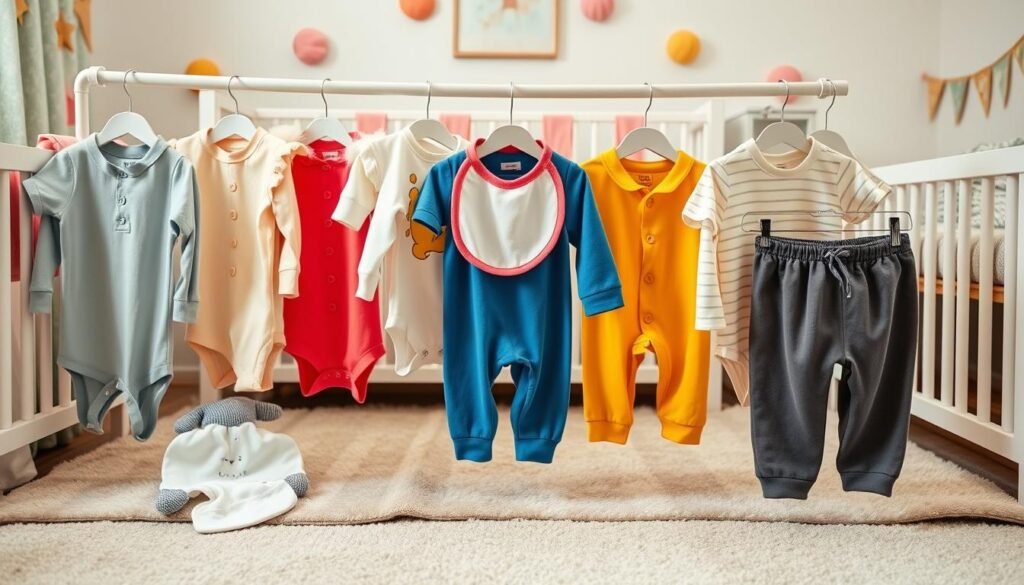
Dressing Your Almost-Toddler (9-12 Months)
As your baby gets closer to their first birthday, their clothes needs change. You’ll want to keep the basics but add more varied items. This is for their growing independence and mobility13.
For 9-12 months, have 10-15 onesies or t-shirts, 7-10 pairs of pants, and 5-7 sleepers13. Also, get 3-4 pairs of shoes13. Lightweight jackets or sweaters are great for layering as the seasons change13.
Now, you can add more “outfit” pieces as your baby becomes more active and social. You might have 8-10 onesies or bodysuits, 6 pajamas or sleepers, and 5-7 pairs of pants for your almost-toddlers13. Remember to plan for growth and changing seasons when buying clothes.
| Clothing Item | Recommended Quantity |
|---|---|
| Onesies/T-shirts | 10-15 |
| Pants (including jeans) | 7-10 |
| Sleepers | 5-7 |
| Shoes | 3-4 |
| Jackets/Sweaters | As needed |
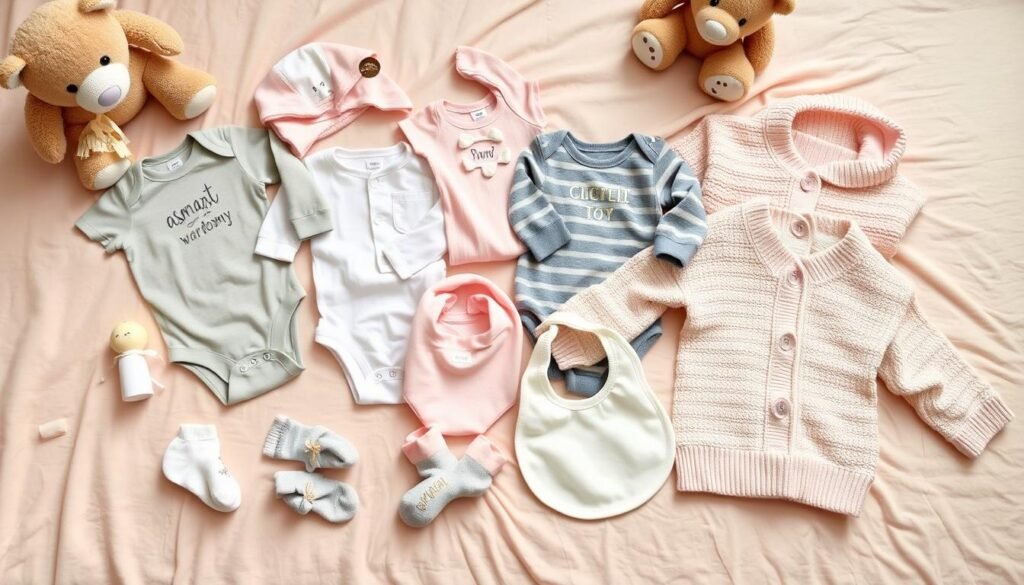
It’s important to balance baby wardrobe essentials with your infant clothing needs as your little one grows. With a well-planned wardrobe, your almost-toddler will be comfortable, stylish, and ready for any adventure141513.
Seasonal Considerations and Weather-Appropriate Clothing
As a parent, it’s important to change your baby’s clothes with the seasons. This keeps them comfy and safe. Here are some tips for dressing your baby for different seasons.
Summer Essentials and Layering Tips
In summer, choose light, breathable fabrics like cotton. Get sun hats, light jackets for cool places, and swimwear for water activities.16 Babies lose heat fast because their skin is thin. They can get hot or cold quickly. So, layering is essential to adjust to temperature changes.
Winter Wardrobe Must-Haves
In winter, dress your baby warmly with layers. Must-haves include fleece jackets, mittens, hats, and warm socks. For really cold places, add a bunting or snowsuit17. Babies born in November to March need warm clothes like long-sleeved onesies and hats17.
Babies lose heat fast because of their body size. Dress them in layers to keep them at the right temperature. This is true for both outside and indoors.
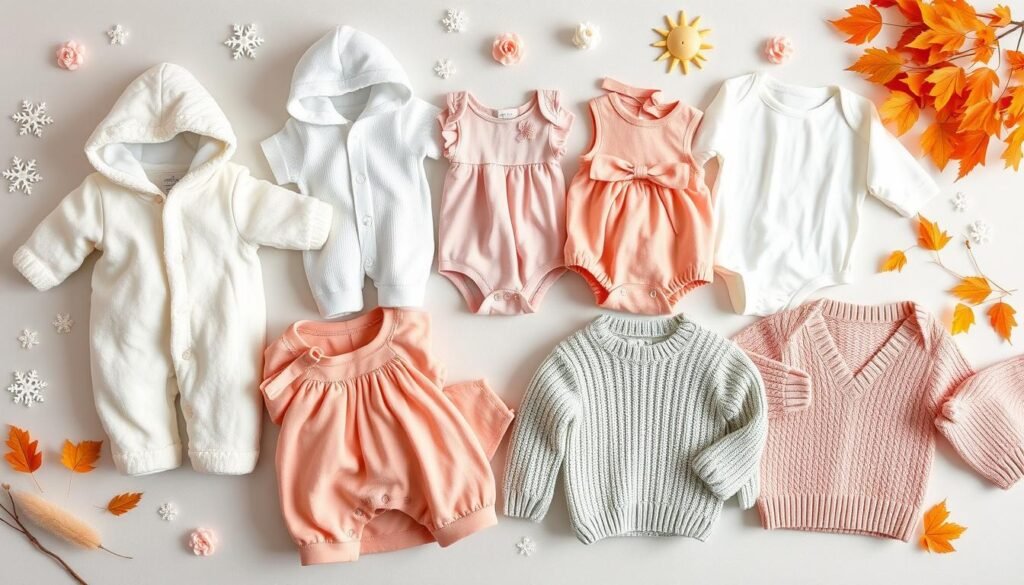
By watching the weather and your baby’s needs, you can dress them right. This keeps them comfy, safe, and ready for every season.
Smart Shopping Tips for Baby Clothes
Getting ready for your baby’s wardrobe can be both thrilling and daunting. But, with some clever shopping tips, you can create a budget-friendly wardrobe for your child18.
One smart move is to buy clothes a size bigger to keep up with your baby’s fast growth. This way, your baby can wear each piece for longer18. Also, watch for end-of-season sales for next year’s clothes at a discount.
Second-hand shopping is another great option. You can find gently used baby clothes at thrift stores, consignment shops, or online. It’s a cost-effective way to get items like formal outfits that are only worn briefly19.
For everyday items like onesies, pajamas, and socks, choose quality over quantity18. These are staples your baby will wear often. For special occasions, you can spend less since these outfits are used less.
Lastly, pick versatile pieces that can be mixed and matched. This way, you get more value from each item and make dressing your baby easier19.
By using these smart shopping tips, you can build a comprehensive, budget-friendly wardrobe for your baby. This will keep them comfortable and stylish for their first year1819.
Managing Laundry and Clothing Organization
Keeping up with your baby’s clothes is essential. I wash my kids’ clothes every 2-3 days. I use gentle, baby-safe detergents and wash new clothes before they wear them20. This way, their clothes stay clean and fresh, and I never run out of clean clothes20.
Creating an Efficient Laundry Schedule
Sorting clothes by size and type makes getting outfits easier. I use drawer dividers or small boxes for socks, onesies, and other small items21. This keeps everything organized. For clothes that are out of season or too small, I store them in labeled containers21.
Storage Solutions for Different Sizes
I keep my kids’ wardrobe minimal to avoid too much clutter21. I have a Google document with a list of sizes and quantities needed for each child21. This helps me stay organized and avoid buying too much21.
Any clothes that don’t fit or are damaged get thrown away21. Clothes in good shape are stored, sold, or donated21. This method keeps their closets tidy and their wardrobe needs met21.
